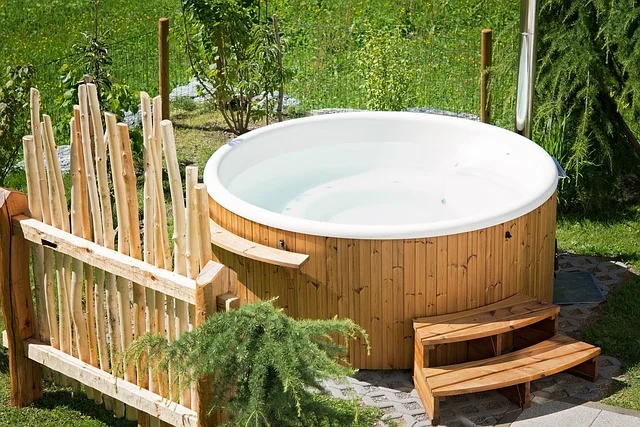Hot tubs, while offering a luxury relaxation experience, inevitably face wear and tear. When they reach the end of their life span, or perhaps no longer align with a homeowner’s preference, the dilemma arises: How does one properly dispose of this hefty structure?
To dispose of a hot tub, first drain and disconnect it from power sources. Then, dismantle it into manageable parts. Consider recycling, hiring professional removal services, or selling/donating if in good condition. Always prioritize safety and eco-friendly methods.
Fear not, for this guide offers further insights and methods, based on firsthand experience and expertise, on how to dispose of a hot tub effectively.
How to Dispose of a Hot Tub

Disposing of a hot tub requires a strategic approach, as it’s not as straightforward as taking out everyday trash.
Here’s a more in-depth exploration:
- Preparation: Before anything else, ensure the power and water supply to the tub are entirely shut off. Disconnecting all electrical and plumbing connections is pivotal for safety.
- Draining the Tub: Use the built-in drain plug or a submersible pump to remove all the water. Ensure the water flows away from any structures or plants.
- Dismantling the Tub: Use a reciprocating saw, hammers, and screwdrivers to dismantle the structure. While cutting, divide the tub into manageable segments, keeping in mind the material disposal restrictions in your area.
- Sorting Components: As you disassemble, categorize components by material: plastics, metals, and non-recyclables. This systematic approach can ease the recycling and disposal process.
- Disposal: Depending on your municipality, certain large-item disposal services or specialized facilities might accept hot tub parts. Always check local regulations and guidelines.
Recycling Your Hot Tub
Embrace a green approach and recycle as much of your hot tub as possible. Here’s how:
- Metal Components: The frame, screws, and sometimes the shell reinforcement consist of recyclable metals. Local scrapyards often buy these for a good price.
- Plastic Elements: The exterior cabinet, internal shell, and piping often comprise recyclable plastics. Reach out to your local recycling center to ascertain which components they accept.
- Electrical Components: The heater, pumps, and control systems can be recycled as electronic waste. Some specialized centers might even refurbish and reuse them.
Selling or Donating
Instead of disposal, think about passing the relaxation forward:
- Selling: Many people look for used hot tubs as an affordable entry into spa relaxation. Clean and refurbish your tub as much as possible to make it appealing. Platforms like eBay, Craigslist, and Facebook Marketplace are great places to list.
- Donating: Several charitable organizations or community centers accept hot tub donations. Ensure the tub is in good working condition, clean, and sanitized before offering it up. Plus, donations can sometimes offer tax write-offs, so keep your documentation.
Repurposing Your Hot Tub
Breathe new life into your old tub by transforming its purpose:
- Garden Planters: With some creative landscaping, turn your hot tub into a beautiful garden bed. The depth is ideal for growing a variety of plants, from flowers to vegetables.
- Pond or Water Feature: Clean the tub thoroughly, add a pond liner, and create a serene backyard pond. Incorporate aquatic plants, ornamental fish, and perhaps even a fountain for a peaceful retreat.
- Storage Bin: After a good cleaning, use the tub as a unique storage solution. It could be ideal for storing large garden tools, and children’s outdoor toys, or even as a cooler for large parties!
- Children’s Sandbox: Convert the tub into a sandbox where kids can play and build castles. Just add clean sand and ensure any sharp edges are safely covered.
Contacting Professional Services
Professional services can simplify the process of hot tub disposal for homeowners. These trained experts possess the knowledge, tools, and resources necessary to safely and efficiently handle hot tubs of all shapes and sizes:
- Researching Reputable Companies: Begin by searching for companies that specialize in hot tub removal or large item disposal. Online reviews, BBB ratings, and recommendations from friends or neighbors can guide you toward trustworthy providers.
- Inquiring About Services: Once you’ve shortlisted potential companies, reach out for more information. Some companies may provide dismantling services, while others may only handle pick-up of already disassembled tubs.
- Safety and Liability: Ensure the chosen company is licensed and insured. This protects you from potential liabilities in case of accidents or damage during the disposal process.
- Scheduling a Pick-up: Once you’ve settled on a service provider, arrange a convenient pick-up date. Clear any obstacles from the hot tub’s location to the pick-up spot to facilitate easier removal.
- Documentation: Always ask for a receipt or some form of documentation. This verifies that your hot tub was disposed of properly and can be useful for future reference.
Eco-friendly Disposal
Opting for an environmentally friendly disposal method can be a rewarding choice, considering the positive impact on the environment:
- Landfill Alternatives: Landfills are becoming increasingly congested. Instead of adding to this burden, explore alternatives. This can include recycling centers or services that transform waste into energy.
- Parts Recycling: Hot tubs consist of various recyclable components, from metal frames to plastic shells. Segregate and transport these to appropriate recycling facilities.
- Eco-friendly Junk Removal Services: Some professional services specialize in green disposal methods. These companies commit to recycling or repurposing as much of the material as possible, ensuring minimal landfill impact.
- Local Regulations: Always stay informed about local disposal guidelines. Some municipalities have specific procedures for environmentally friendly disposal, ensuring reduced environmental harm.
The Costs Involved
Understanding the costs associated with hot tub disposal can prevent unexpected expenses and ensure budget-friendly decisions:
- Self-disposal: While this option might seem cost-effective initially, consider the costs of tools (if you don’t have them), vehicle rentals for transportation, and potential disposal fees at landfills or recycling centers.
- Professional Services: Charges for professional removal services can vary based on your location, the size of the tub, and the extent of the services offered. Typically, prices can range from $100 to $500.
- Eco-friendly Options: While some green disposal methods might come with an added cost, consider the long-term environmental benefits. Plus, recycling certain components, like metals, might even fetch you some money.
- Selling or Donating: If your tub is in good condition, selling can offset disposal costs. Similarly, donating your tub might provide tax deduction opportunities, providing indirect financial benefits.
Safety First!

When dealing with the disposal of a substantial item like a hot tub, safety should never be an afterthought.
Here’s how you can ensure a secure process:
- Electrical Precautions: Before beginning any dismantling or removal processes, it’s paramount to disconnect the hot tub from all power sources. Handling electrical components can be hazardous, especially in wet environments.
- Avoiding Chemical Exposure: If you’ve been using your hot tub, it likely contains chemicals to maintain water cleanliness. Ensure you properly dispose of any remaining water and avoid direct contact with chemicals.
- Lifting Techniques: A hot tub is heavy, and even when broken down into parts, each piece can be cumbersome. Always use proper lifting techniques, engage your core muscles, and ideally, work with a partner or team.
- Tool Safety: If you’re dismantling the hot tub yourself, handle tools with care. Sharp edges, saws, or even errant screws can lead to injuries if not dealt with appropriately.
- Protective Gear: Wear gloves, safety goggles, and sturdy footwear when working on your hot tub. These can prevent cuts, and abrasions, and protect from any splinters or shards.
The Environmental Impact Of Hot Tub Disposal
As with many disposal tasks, getting rid of a hot tub has an environmental footprint.
Here’s a closer look:
- Waste Contribution: If not disposed of correctly, hot tubs can end up in landfills, contributing to environmental degradation and loss of valuable landfill space.
- Chemical Runoff: Incorrectly draining hot tub water can introduce chemicals into the environment. These can have harmful effects on plants, animals, and even local water supplies.
- Resource Reuse: On a brighter note, parts of your hot tub, such as metals or plastics, can be recycled. This recycling not only reduces waste but also conserves resources by cutting down on the need to produce new materials.
- Carbon Footprint: Transporting and processing waste uses energy and, in turn, produces carbon emissions. By opting for eco-friendly disposal methods or recycling parts, you can limit your carbon footprint.
Final Words on How to Dispose of a Hot Tub

Disposing of a hot tub is a multi-faceted task that requires careful consideration of safety, cost, and environmental impact.
While the process might seem daunting initially, a planned and informed approach ensures a smooth transition from having a bulky hot tub to reclaiming your space.
Whether you choose to seek professional assistance, recycle, sell, or repurpose, prioritizing safety and environmental responsibility should be at the forefront.
With the right knowledge and resources, hot tub disposal can be both efficient and eco-friendly, marking a win for homeowners and the planet alike.
I’m Thomas, the owner of SustainableWave. Passionately promoting a sustainable planet. With experience in various eco-roles, I’ll share green tips, sustainability hacks, and personal eco-journeys on my blog.






